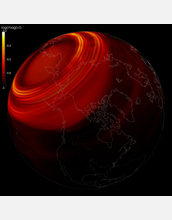Multimedia Gallery
High-fidelity modeling seismic wave propagation improves seismic hazard assessments.
Advanced computing enable high-fidelity modeling of the propagation of seismic waves through the earth, which will help provide a better understanding of the structure of earth's interior, and will help improve assessments of seismic hazard. Solving the seismic wave propagation equations to frequencies of interest taxes existing supercomputers. Stampede provides the computational resources needed to incorporate earthquake observations into improved earth models through inverse theory.
Credit: Carsten Burstedde, Omar Ghattas, James R. Martin, Georg Stadler, Lucas C. Wilcox, ICES, The University of Texas at Austin. Visualization by Gregory D. Abram, Texas Advanced Computing Center.
Images credited to the National Science Foundation, a federal agency, are in the public domain. The images were created by employees of the United States Government as part of their official duties or prepared by contractors as "works for hire" for NSF. You may freely use NSF-credited images and, at your discretion, credit NSF with a "Courtesy: National Science Foundation" notation.
Additional information about general usage can be found in Conditions.
Also Available:
Download the high-resolution JPG version of the image. (263 KB)
Use your mouse to right-click (Mac users may need to Ctrl-click) the link above and choose the option that will save the file or target to your computer.
Related story: Stampede Charges Computational Science Forward in Tackling Complex Societal Challenges



